There is an albatross hanging around the neck of the latest FromSoftware release, the same as every FromSoftware release: difficulty. The problem is that talking about difficulty in the abstract like it’s a set value is boring, reactionary, and not particularly productive, It obfuscates the real trade-offs that From often makes with their games, and Shadow of the Erdtree is very much a game of trade-offs. And the worst thing about it is that talking about these games critically with nuance is simply not that difficult.
Mixed Blessings
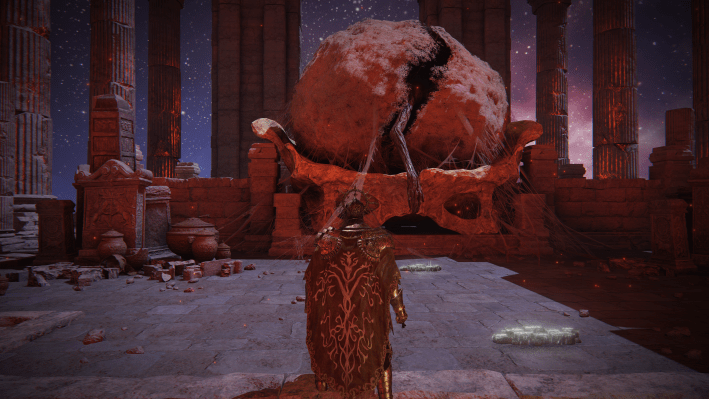
Shadow of the Erdtree is the DLC expansion to Elden Ring and from the jump, it is not an easy bit of DLC to unlock, requiring that you have beaten Mogh, an optional boss hidden in a fairly out of the way place. The placement, aside from its lore implications, is a significant choice and establishes who the DLC was always meant for: everyone who has beaten the extreme ends of Elden Ring into the ground, have hit the ends of the base game and gotten to around level 150. By touching the The Cocoon of the Empyrean, you are transported to The Land of Shadow, a reality with its own special rules.
Warning: Minor location, weapon, and boss spoilers ahead, although I have attempted to avoid discussing major plot elements whenever possible.
The second you go into the Land of Shadow, you quickly notice that everything in it hits you like a fucking fire truck. To balance the fact that people are probably overleveled going into this expansion, Shadow of the Erdtree introduces a new mechanic, centred around items called Scadutree Fragments. By collecting these fragments, you are able to power up both the damage you deal and the damage you take. This is where nuance is important, because while the rationale for this system is smart and addresses a very real problem, it’s implemented quite badly.

It is clear that FromSoftware, who have created a gargantuan world, would like you to explore all of it instead of just boss rushing the whole thing, (To reduce this release to simple DLC would be underselling it, although I disagree that this is basically a sequel.) But they both clumsily tell you about the Scadutree Fragment system while never really stressing how significant a difference it makes in the basic playability of the DLC. The scaling, at least at launch, was gargantuan. What's more, by hiding leveling in a Korok-ass collectible, progression becomes a fetch quest.
This would be fine if there was some kind of cohesion about where shards appear, but there’s only a vague rhyme or reason behind their placement. Initially it seems like they mostly stay around crucifixes, but sometimes guys who have jars have them, and sometimes they are near statues, but also sometimes big hippos carry them, and once I saw one in a coffin under a waterfall. You could argue that this is no different than hiding Golden Seed flask upgrades, but I feel like those are fundamentally different mechanics. There’s a better way they could have done this, and I feel slightly vindicated here given the fact that they aggressively patched the scaling of the system as I was writing this blog, making the initial Scadutree Fragments more significant, and the later ones more gradual.
Lands Between
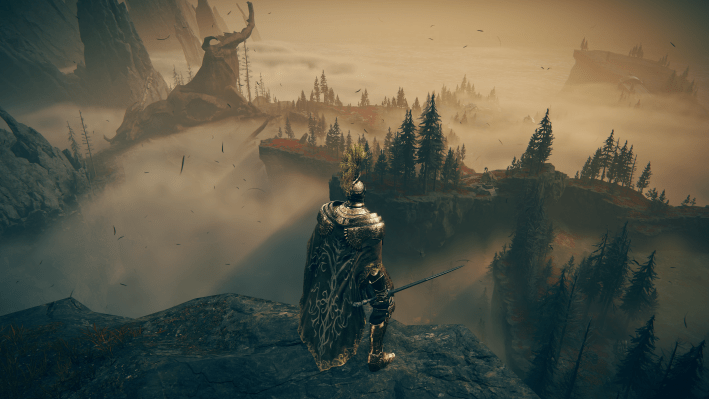
Forcing the player to explore the world is a valid choice, because Shadow of the Erdtree has some of the most gorgeous landscapes I have ever seen in a game. But many of those vistas are also a little empty, even by Elden Ring standards. It’s not uncommon to see beautiful, striking biome in the distance, get there, and then find like two things to do in them.
I do admit there’s a kind of beauty to a huge, empty space. The Abyssal Woods are terrifying, so much so that your mount will not let you summon it, forcing you to take this space on foot. And some of these locations serve important storytelling purposes just by dint of being there, like the Finger Ruins. And yet I can’t shake the feeling that the entire thing was either scaled back at one point, or that the game itself is simply masquerading as a much larger experience, like a bag of potato chips as my colleague Ash Parrish observed on Aftermath Hours. This was always a fundamental compromise of the base game, particularly near the end, but in Erdtree it is felt much more aggressively. I don’t even know that I want more things to do in those places; the expansion is the perfect length to me, but I can’t help but feel a sense of disappointment, or that these areas feel unfinished, a sensation that Elden Ring delivered much less frequently. Like the base game, Erdtree has a very showy beginning and middle, but loses cohesion in the extremities and the back section. That said, there are real highlights to the end, especially in the way the structure of the final area looks like an impossible Rodin sculpture.
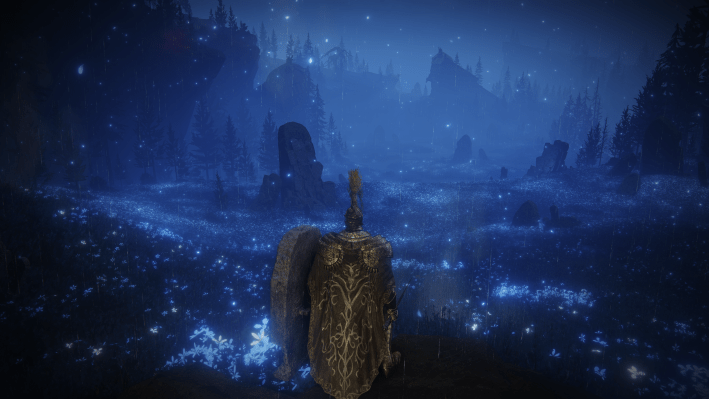
One of the most striking things about the map is its verticality. Much of the Shadow Realm consists of massive cliffs and valleys, and there is something breathtaking about seeing locations far in the distance and wondering “how the hell am I going to get there?” This is a valid question, and one you may ask yourself repeatedly, because the routes to get to those places are inorganic and uneven in a way that I don’t personally find enjoyable. Artistically, there is validity to making huge parts of your map aggressively convoluted to find, but I always found that to be both the most elusive part and greatest weakness of Miquella's Haligtree in the original game. But unlike the Haligtree, there’s no there when you get there in Erdtree, and the tease of having these spaces that are distant and gorgeous but ultimately hollow half the time left me cold.
Who’s the Boss?
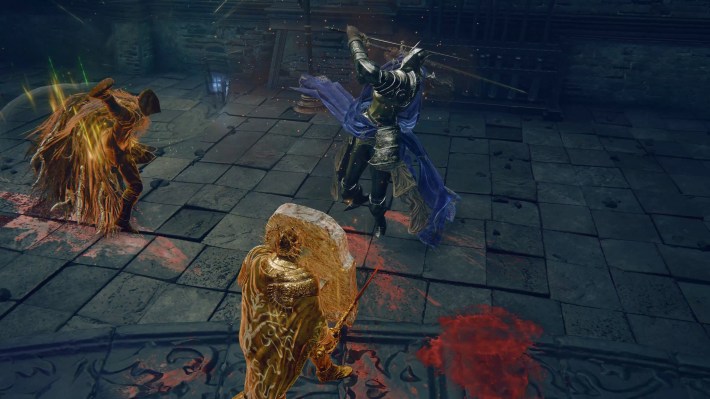
There is also the issue of bosses in this game, and in my fair assessment as a From player, there’s simply a lot of bullshit here. This is not unusual for a From game, and I love a lot of bullshit Souls bosses.
Many of the bosses themselves are the logical conclusion trying to one up Elden Ring, and to account for players already having a medium sized arsenal of disgustingly broken gear. Some of the bosses, like the Golden Hippo or the Shadow Sunflower, are just straight up bad, the big sloppy monster type that is often in line with From’s weakest offerings. A few of the bosses are among their most creative and beautiful designs, featuring gorgeous cutscenes. Rellana and Messmer are standouts here. A huge portion of them have either some tremendously cheesy thermonuclear bomb up their sleeve, some flowing combo similar to Malenia’s Waterfowl Dance, or both. A handful are tuned very bizarrely, and favor certain playstyles and builds overly aggressively. The final boss is particularly guilty of this.
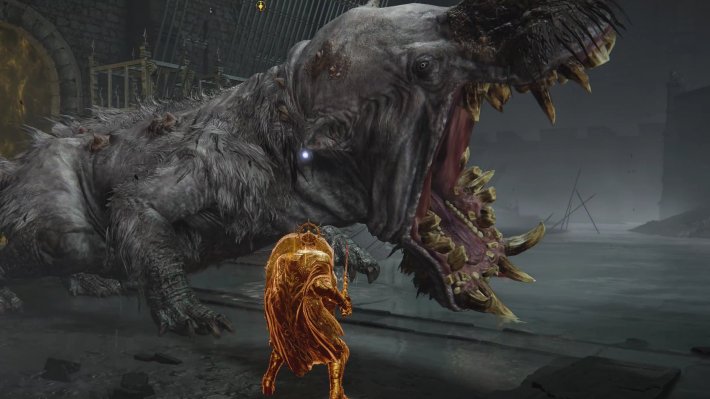
Many of the choices make sense, as Elden Ring’s design was originally about offering the player some unreasonable challenges coupled with almost too many options than could be playtested at launch, and seeing how the player base could break the game. This flexibility gave it a mass market appeal that previous games did not. In terms of design, Erdtree is no different. I see a lot of people complain that these encounters are too “hard,” but a more accurate word is “unsatisfying.” Are these encounters balanced well, and what audience are they balanced for? Is that the same audience of 25 million that bought the game, or diehards who solo Malenia naked wearing a big fungus helmet? Is the friction rewarding and meaningful and does eking out a win feel good? There are some shining standouts, but a lot of times the answer for me is no.
The Shadow of the Erdtree
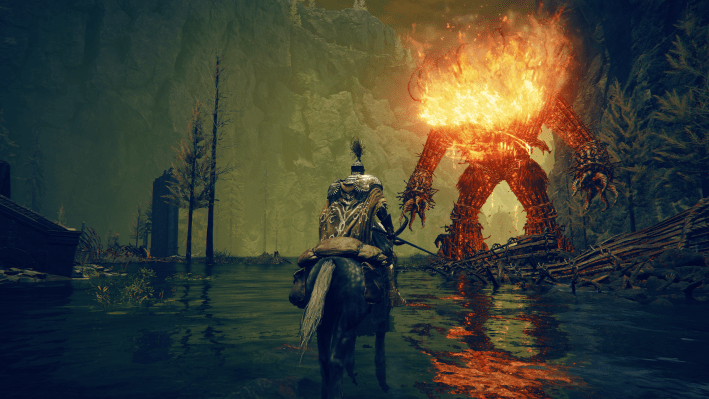
Sometimes I wonder what lessons From took away from the meme-like popularity of Malenia, the optional ultra hard boss hidden deep in an easily missable section of the original game, because I feel her presence, the tradeoffs in her design and location, a lot in this game. But aside from the decisions that are outright bad, I don’t know how much I can fault the developers for how Erdtree is shaped, because many of the things I personally dislike are simply the logical conclusion to conceptual tradeoffs FromSoftware made to make a game as gargantuan as Elden Ring.
Reskinning bosses and locations from other games and encounters has long been one of From’s favorite bits, and oftentimes they are good at recontextualizing assets in a way that either adds a new spin to them, contributes to the lore, or is very funny. Sometimes in Elden Ring this was implemented poorly or contributed to fluff: for example, there’s no reason for me to fight Astel twice, when even as an optional fight this choice made the first fight less special. This also rears its head aggressively in the DLC, where many lesser bosses are reskins of enemies that I have already fought, in a way that is not additive. Many of the dragons you find in the fields will feel familiar. One dragon in particular is very annoyingly balanced in a way that feels both cheap and disrespectful to the original encounter. To From’s credit, however, Bayle The Dread is very much worth fighting.
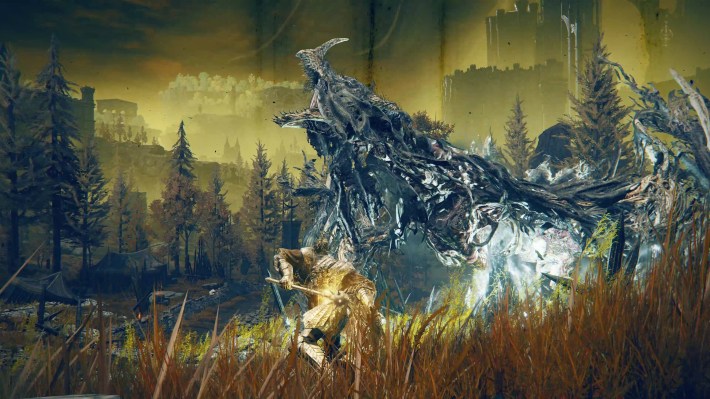
I would be remiss if I did not praise the new gear and spells here. I got through much of the DLC with a weapon called Milady and using an ash called Wing Stance to bleed enemies to death. The hand-to-hand combat weapons are enjoyable, although they feel conservatively balanced to be initially underwhelming. Giant katanas are a welcome touch, as are perfume bottles, which are currently busted the same way Hoarfrost Stomp was at launch. YouTuber Syrobe discovered that Rolling Sparks ash, when aimed at the ground and with a specific loadout, will decimate any boss in less than 20 seconds. Probably the best addition is the Deflecting Hardtear, a flask upgrade that temporarily buffs timed blocks to behave closer to Sekiro. Considering that Sekiro is From’s best game, and people have extensively modded the base game to add Sekiro-style combat, that was a good choice.
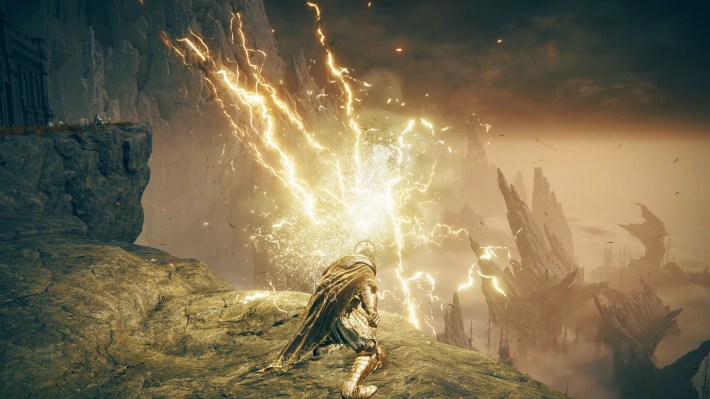
From games aren’t for everyone of course, but they’re also not for every From fan. They don’t have to be, which is an important part of this. I think Bloodborne and Sekiro are their most finely tuned games, in part because they are scoped much tighter. Shadow of the Erdtree needs to account for so many variables because it’s an extension of Elden Ring, itself extended from the Souls games. There’s a million ways to beat every boss; it is an action RPG after all. Chasing that meta is itself a system to engage with, one that I find fun in the abstract but that has never got me to the same place of pure, placid flow as the Genichiro fight from Sekiro or even many of the fights in Armored Core VI.
I should stress that I do very much like Shadow of the Erdtree. There is a lot to praise about it, particularly when it comes to visual design, music and how it adds to the lore, which rank among FromSoftware’s best work. But it is following up on Elden Ring, a once-in-a-decade game that was a singular, impossible achievement when the industry itself seemed devastated by covid. Even if things had gone perfectly, it would be hard to recapture that same sense of grandeur, because the reality is you can’t enter the same Siofra River twice.
“Hit them where they’re weakest”
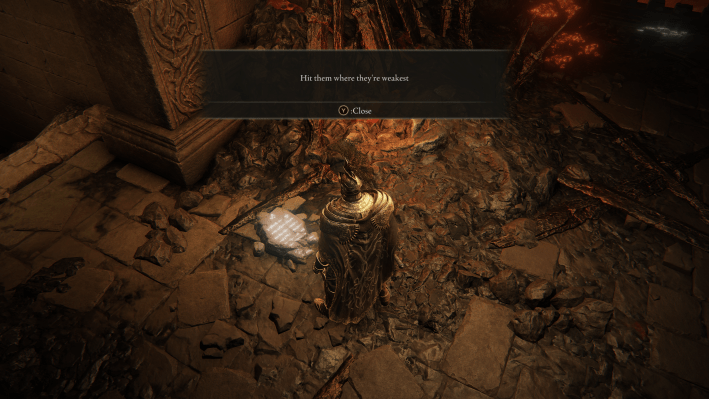
There is one series of choices in Erdtree that may seem very minor but make me mad every time I think about them. Occasionally in the expansion, you will see messages infrequently left on the ground not by players but by the developers. Alexis Ong noted this in their (quite good) Eurogamer review of the game, but I was not prepared for how inelegant these messages are. One group of them pertain to the behaviors of a very specific group of enemies. I will try to avoid spoiling the area or the enemies themselves, but they behave atypically. “Hide yourself,” “Await your chance,” “crouch in the undergrowth,” “combat is not an option.” Aside from sounding like tips in an Ubisoft open world game, that last bit of advice is categorically wrong in ways that are actively misleading, and not in a playful FromSoft way (several player notes around them advise the correct way to deal with the enemies.). There are other examples, like a lumbering golem with high defense and a huge obvious weak spot on its back. The game politely tells me “Hit them where they’re weakest,” as though I would never figure that out under my own steam. The worst offender I saw was a message that just said “I’ll be damned if there isn’t a way past the wall,” which seemed to nudge me to look for a small hole in the back of the building. I would understand this if it was in a mission critical area, but it’s just some side building with some stuff inside it.
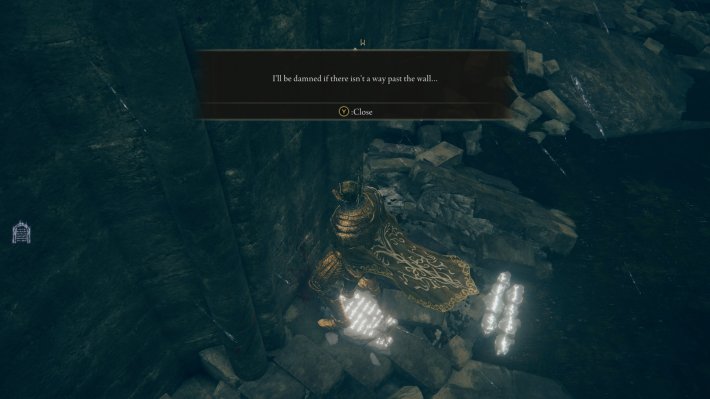
These choices, which I am guessing are the result of playtesting, are baffling to me because it goes against so much of From’s design philosophy. Do they not have faith that the notes laid by players are enough? Are they not confident in their design choices, and if not, why resort to a note instead of addressing those choices? And who do they think is reading these notes, hidden in optional content, down labyrinthine paths, in an aggressively challenging 40 dollar expansion that is, itself, hidden inside an optional end game dungeon? Again, it’s a very minor complaint in the grand scheme of things, but it made me severely doubt that From totally knows what they are doing, which I don’t do that often.
Sound and Fury
The worst part about all of this is the sheer amount of noise adjacent to any criticism of From games. Many people can be normal. But when it does manifest it’s either wildly reductive to the work or, more often, a childish accusation that the critic does not understand or is bad at the game. (I saw this happen in real time about the aforementioned EuroGamer review.) The latter is some Reddit six years ago shit, so much so that it feels quaint. This is annoying because I know firsthand that if you willingly sign up for FromSoft duty at a publication you’re very probably qualified to do it. I know this because I have been on hand for these pre-release. It can be gruelling and I am glad that I have never had to put a number next to any of them. The largest issue is that these games are designed for and react to the ecosystem they are released in, and so going into one of them half blind and under a hard deadline before that equilibrium is established is fundamentally more difficult and limited than the average player will face. This goes doubly so for people who do guides work; they are saints and angels who hold up half of the world.
But even in ideal conditions, my favorite conversations about these games happen well after their release. I have talked to friends who rank this expansion among their favorite things FromSoftware has ever done, and others who really hated it in the second half. Aside from being living texts, people’s relationships to these games are deeply personal, and I feel better having taken my time with Shadow of the Erdtree, to have digested it like a big meal, and to think about how it sat with me. I am glad that I can write this without SEO optimization or deadlines. I think these games deserve nuance, but what do I know? I liked Dark Souls 2.
See? That wasn’t that difficult.


